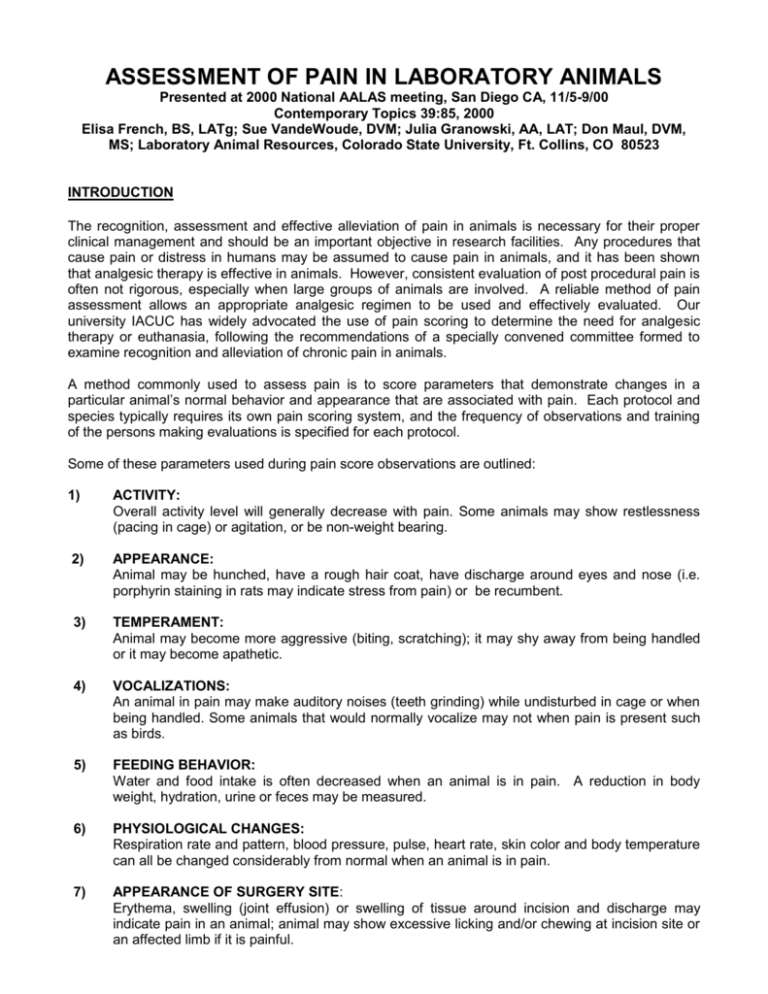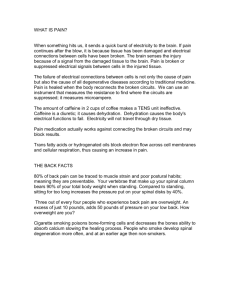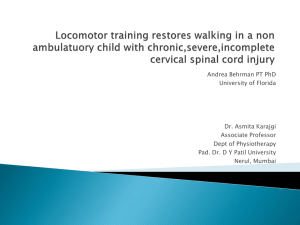assessment of pain in laboratory animals
advertisement

ASSESSMENT OF PAIN IN LABORATORY ANIMALS Presented at 2000 National AALAS meeting, San Diego CA, 11/5-9/00 Contemporary Topics 39:85, 2000 Elisa French, BS, LATg; Sue VandeWoude, DVM; Julia Granowski, AA, LAT; Don Maul, DVM, MS; Laboratory Animal Resources, Colorado State University, Ft. Collins, CO 80523 INTRODUCTION The recognition, assessment and effective alleviation of pain in animals is necessary for their proper clinical management and should be an important objective in research facilities. Any procedures that cause pain or distress in humans may be assumed to cause pain in animals, and it has been shown that analgesic therapy is effective in animals. However, consistent evaluation of post procedural pain is often not rigorous, especially when large groups of animals are involved. A reliable method of pain assessment allows an appropriate analgesic regimen to be used and effectively evaluated. Our university IACUC has widely advocated the use of pain scoring to determine the need for analgesic therapy or euthanasia, following the recommendations of a specially convened committee formed to examine recognition and alleviation of chronic pain in animals. A method commonly used to assess pain is to score parameters that demonstrate changes in a particular animal’s normal behavior and appearance that are associated with pain. Each protocol and species typically requires its own pain scoring system, and the frequency of observations and training of the persons making evaluations is specified for each protocol. Some of these parameters used during pain score observations are outlined: 1) ACTIVITY: Overall activity level will generally decrease with pain. Some animals may show restlessness (pacing in cage) or agitation, or be non-weight bearing. 2) APPEARANCE: Animal may be hunched, have a rough hair coat, have discharge around eyes and nose (i.e. porphyrin staining in rats may indicate stress from pain) or be recumbent. 3) TEMPERAMENT: Animal may become more aggressive (biting, scratching); it may shy away from being handled or it may become apathetic. 4) VOCALIZATIONS: An animal in pain may make auditory noises (teeth grinding) while undisturbed in cage or when being handled. Some animals that would normally vocalize may not when pain is present such as birds. 5) FEEDING BEHAVIOR: Water and food intake is often decreased when an animal is in pain. A reduction in body weight, hydration, urine or feces may be measured. 6) PHYSIOLOGICAL CHANGES: Respiration rate and pattern, blood pressure, pulse, heart rate, skin color and body temperature can all be changed considerably from normal when an animal is in pain. 7) APPEARANCE OF SURGERY SITE: Erythema, swelling (joint effusion) or swelling of tissue around incision and discharge may indicate pain in an animal; animal may show excessive licking and/or chewing at incision site or an affected limb if it is painful. Examples of some pain scores that have been developed and utilized by CSU investigators include sheep used in orthopedic, neurologic, or reproductive research; horses on orthopedic or reproductive studies; guinea pigs used in Mycobacterial studies; rats used in orthopedic or neurologic studies; birds used on orthopedic and analgesic studies; and rabbits used on orthopedic studies. Some of these examples are illustrated: DOGS - Following orthopedic stifle surgery: 1. 2. 3. 4. 5. 6. 7. 8. 9. AGITATION 0 = asleep or calm 1 = mild agitation 2 = moderate agitation 3 = hysterical CRYING 0 = not crying 1 = crying, responds to voice or touch 2 = crying, no response to voice or touch MOVEMENT 0 = none 1 = frequent position changes 2 = thrashing HEART RATE – above pre-operative value 0 = 0 to 15 % 1 = 16 to 29 % 2 = 30 to 45 % 3= > 45 % RESPIRATORY RATE – above pre-operative value 0 = 0 to 15 % 1 = 16 to 29 % 2 = 30 to 45 % 3= > 45 % GAIT AT WALK 0 = weight bearing continuously 1 = weight bearing lightly or intermittently 2 = toe touches, not weight bearing 3 = carries limb STANDING 0 = continuously weight bearing 1 = intermittent weight bearing 2 = carries limb JOINT EFFUSION 0 = none 1 = mild 2 = obvious STIFLE THICKNESS Diameter of operated stifle at the level of the epicondyles “ normal “ “ “ “ “ “ “ Ratio of operated to normal stifle Score: = Ratio x 2 LARGE ANIMALS – Following orthopedic stifle surgery: 1. 2. 3. 4. 5. 6. 7. COMFORT = “over the fence” observation 0 = awake, interested in surroundings, recumbent, eating 1 = awake, not interested in surroundings, recumbent, reduced appetite 2 = lethargic, depressed appearance, anorexic 3 = head down, lethargic (ears stay drooped), anorexic, bruxism 4 = recumbent, fixed look and staring, eyes half closed, little response when prodded, bruxism MOVEMENT 0 = normal ambulation, no lameness 1 = slight lameness, toe touching 2 = lameness, some toe touching, otherwise limb carried 3 = lameness, limb carried (non-weight bearing) except when herded 4 = lameness, limb carried (non-weight bearing) even when herded FLOCK BEHAVIOR 0 = normal – moves with flock 1 = mild changes - lags behind but catches up 2 = moderate changes - lags behind but catches up 3 = severe changes – no interest in flock FEEDING BEHAVIOR 0 = normal – at feed trough 1 = mild changes 2 = moderate changes 3 = severe changes – anorexic RESPIRATORY RATE – in shade 0 = normal 1 = noticeable increase 2 = hyperventilation 3 = hyperventilation with mouth breathing PALPATION SORENESS & RANGE OF MOTION SORENESS 0 = none 1 = mild pain 2 = moderate pain (withdraws limb) 3 = severe pain (withdraws limb, bites, tries to escape) SOFT TISSUE SWELLING, JOINT EFFUSION, & HEAT (CENTERED AROUND JOINT) 0 = none 1 = slight 2 = mild 3 = moderate 4 = severe RABBITS – Following femoral orthopedic surgery: 1. 2. STANDING 0 = continuous weight bearing 1 = intermittent weight bearing 2 = completely non-weight bearing GAIT WITH MOVEMENT 0 = continuous weight bearing 1 = intermittent weight bearing 2 = toe touches, non-weight bearing 3 = non-weight bearing 3. 4. 5. 6. 7. SWELLING 0 = none 1 = mild 2 = obvious PAIN ON PALPATION OF OPERATED LIMB 0 = none 1 = mild pain (occasional vocalization) 2 = moderate pain (frequent vocalization) 3 = severe pain (vociferous vocalization, withdraws limb, bites, struggles) BEHAVIOR 0 = normal cage exploration, food and water consumption, animal calm in cage 1 = minimal exploration, food and water consumption 2 = no cage exploration, hunched position – movement when stimulated, anorexic for 24 hours 3 = no cage exploration, hunched position, piloerection, no movement, anorexic, increased respiratory rate or labored breathing BODY TEMP 0 = normal 1 = > 103 with lameness score of 5 or > 104 with lameness score < 5 2 = > 104 for 24 hrs post treatment and anorexic 3 = > 104 for 48 hrs post treatment and anorexic APPEARANCE OF INCISION SITE 0 = clean, no chewing, no redness 1 = mild chewing, redness, suture intact 2 = severe chewing, incision open 3 = incision infected (redness, swelling, purulent drainage) RODENTS – Arthritic Study 1. 2. 3. 4. BODY WEIGHT – based on pre-study values 0 = < - 5 % decrease 1 = 6 - 10 % “ 2 = 11 - 20 % “ 3 = 21 - 25 % “ 4 = > - 25% “ LAMENESS 0 = none 1 = mild, single limb lameness 2 = moderate, multiple limb lameness 3 = severe, non-weight bearing on any limb APPEARANCE 0 = normal 1 = huddled, mild piloerection, moves when stimulated 2 = huddled, moderate pilo-erection, reluctant to move 3 = huddled, ungroomed, severe piloerection, no movement or moribund ARTHRITIS SCORE 0 = normal 1 = mild erythema, no swelling or limb deformity 2 = moderate erythema, mild swelling, no limb deformity 3 = moderate erythema, moderate swelling, mild limb deformity 4 = severe erythema, severe swelling, moderate to severe limb deformity BIRDS – Humeral Orthopedic Surgery 1. 2. 3. 4. RESPIRATORY RATE – Based on pre-operative levels 0 = < 10% increase 1 = < 50% “ 2 = < 100% “ 3 = > 100% “ HEART RATE – Based on pre-operative levels 0 = < 10% increase 1 = < 50% “ 2 = < 100% “ 3 = > 100% “ APPEARANCE 0 = cooing, standing on perch, feathers normal, preening 1 = cooing, not standing on perch, or feathers ruffled 2 = quiet, not standing on perch and feathers ruffled 3 = huddled, not preening, anorexic, unwilling to move BODY WEIGHT – Based on pre-study values 0 = < 5% weight loss 1 = <10% “ “ 2 = < 15% “ “ 3 = < 15% but > 20% weight loss 4 = >20% weight loss Each pain scale has a corresponding action plan. For example, the lameness assessment action plan for rabbits following orthopedic surgery: Score 0-3 total score or <1 score in a category: No intervention 4-9 total score or >1 score in a category: Administer buprenorphine – 2 doses (0.05 mg/kg), at 12 hour intervals for 24 hours, and re-evaluate pain score. 10 – 11: Administer buprenorphine – 1 dose (0.05 mg/kg, subcutaneously) and re-evaluate pain score in 1 hour. If pain is not controlled, administer flunixin meglumine (1.1 mg/kg subcutaneously) and re-evaluate in 1 hour. If still not controlled then euthanize. If pain is controlled after either of the above treatments, reevaluate at 6 and 12 hours and administer second dose of buprenorphine at 8 hours. Re-evaluate pain score at 12 hours after second dose. If pain is controlled, continue with 2 or more doses over 24 hours. Discontinue at 24 hours after first dose and re-evaluate pain score. DISCUSSION Pain scores are recorded on animal records to assist the IACUC and veterinary staff in evaluating the outcome of protocols. Often the IACUC will ask for a synopsis of the pain scores in order to assess the level of discomfort animals will experience with a certain procedure. This evaluation helps the committee to determine if further analgesics or palliative measures may be required before a new study or amendment is approved. Each animal is scored and analgesics administered according to that score. In general, the higher the score the higher the dose (or frequency) of analgesics. A higher score or a score that does not change after analgesic therapy may indicate that a different analgesia may be necessary, or that the animal should be euthanized. Generally, these pain scores and criteria are reviewed and approved by the CSU IACUC. On several occasions, IACUC members have observed and scored animals following procedures to verify that the pain scoring is an accurate way to assess the condition of the animal. CSU animal care technicians are often involved in performing pain assessments or administering analgesics. It is important for the individual who is performing the scoring to be familiar with the normal behavior of the particular species. The animal care technicians at CSU are often the most knowledgeable of the studies and species in their areas and are the best candidates to perform this assessment. Refinement is still needed for each of these example assessment forms, particularly with variation between observers (the number of observers should be limited) and the poor predictive value of some of the variables (a species and procedure specific score system is generally necessary). Nevertheless, these pain scores have given CSU researchers a more objective and accurate form of pain assessment for each animal undergoing procedures, allowing pain to be managed with a greater accuracy and consistency.








